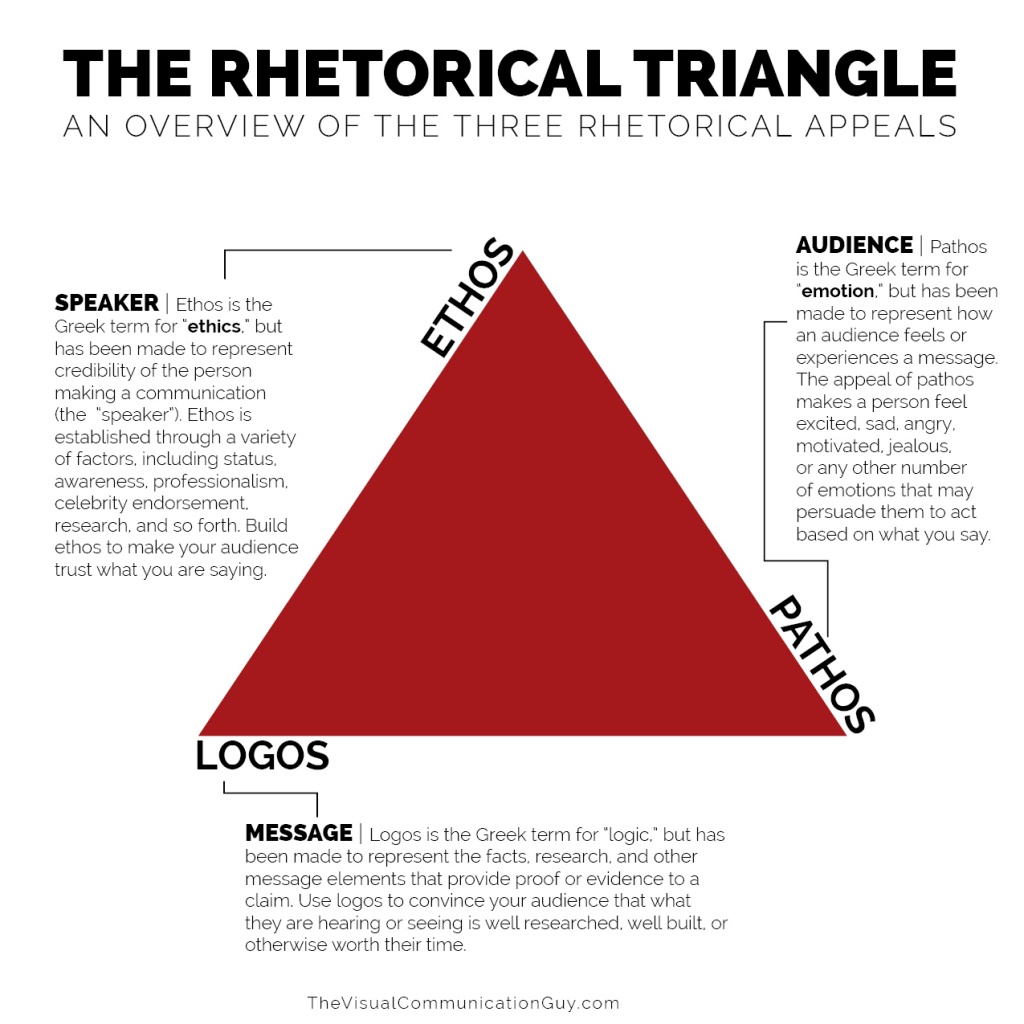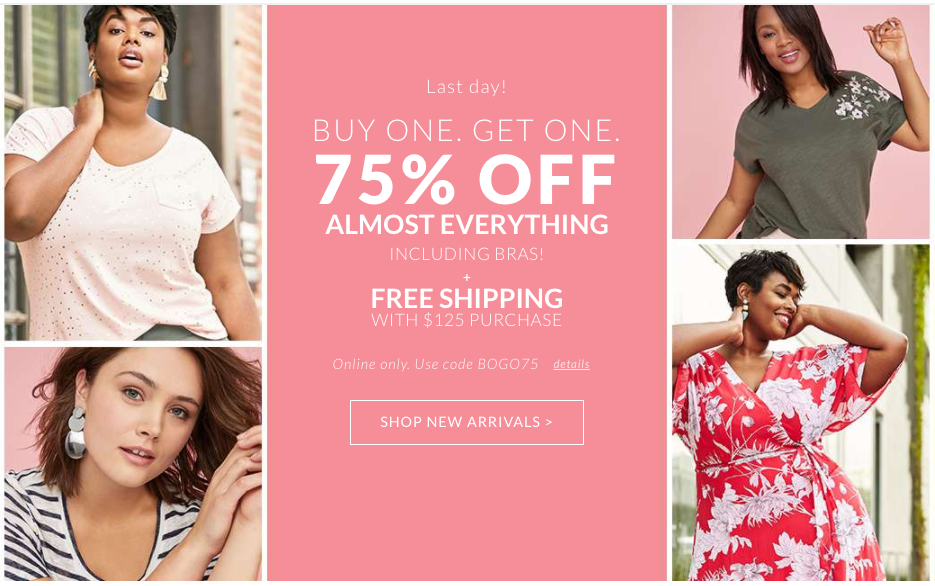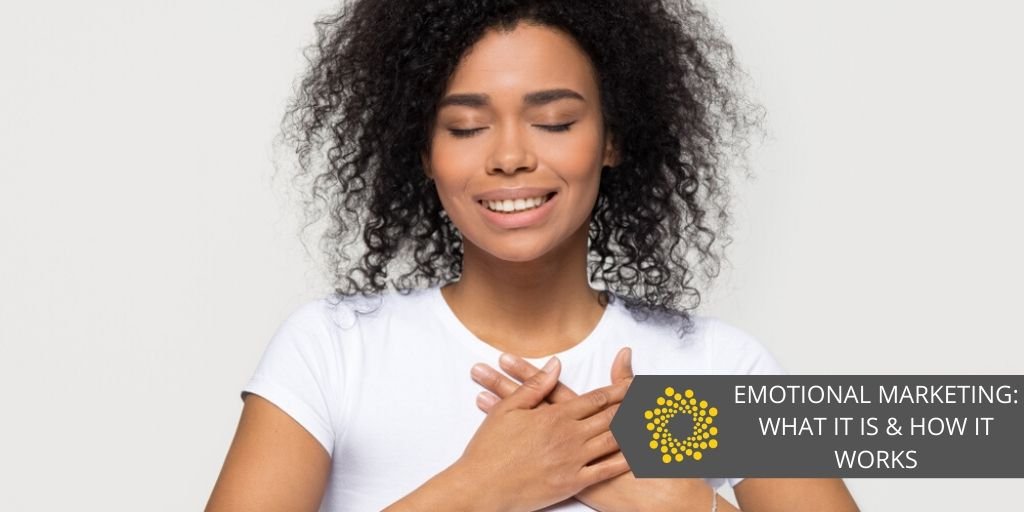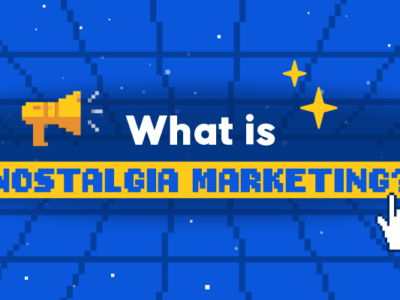Using emotion to persuade people is not a new practice. It’s been done since the time of Aristotle and maybe even before that. In fact, the great Greek philosopher identified emotion as one of the three techniques to appeal to and persuade the audience.
First is logos, or a way of convincing your audience using facts and figures, while the use of authority or credibility is called ethos. Lastly, pathos appeals to emotion. It’s a way of persuading your audience by means of an emotional response or trigger. It draws out feelings such as happiness, anger, or guilt in the audience.

Image Source: The Visual Communication Guy
Because it’s an effective persuasion technique, businesses are now capitalizing on human emotion in a multitude of ways to reach different goals—brand awareness, more sales, and customer retention, among other things. After all, marketing is about persuasion.
What is Emotional Marketing?
Emotional marketing is the deliberate use of persuasive messages that tap into human emotion to form a deep connection with the audience toward achieving the desired result. Often, it appeals to a single emotion only. It can be fear, anger, joy, or any other human emotion that is strong enough to influence decision-making or urge an action, which translates to emotional buying.
Why is Emotional Marketing So Effective?
Emotion is such a strong force. It’s powerful in many ways because it can influence a decision and urge people to act. That’s why it has been an effective marketing technique to inspire people to take specific actions and reach business milestones.
Human emotion, especially when negative, lingers and is haunting. People feel uneasy when their emotions are unaddressed, hence the need to free oneself from it and act on it. Most often than not, this action gives businesses better sales figures—ads with an above-average emotional response from consumers caused a 23% sales increase as opposed to average ads, according to a 2016 Nielsen study.
So, what makes emotional marketing so effective?
1. You become more memorable.
Apparently, emotion and memory are somehow linked together as people have a higher tendency to have longer-lasting memory when it comes to emotionally charged events. When you leave an emotional impact on your audience, your brand, and your content will stick in their hearts and minds.
2. Your content becomes more shareable.
People love to share stories or things, especially when it makes them feel—whether good or bad. It’s just human nature.
3. It influences purchasing decisions.
According to a study, 31% of ads with emotional pull succeeded versus the 16% success of ads that focused on rational content. Clearly, an emotional response to an ad can influence the intent to make a purchase. Thus, the concept of an emotional purchase is born.
4. It helps build customer loyalty and produce brand advocates.
Another study shows that customers who have an emotional relationship with a brand have a 306% higher lifetime value and will likely recommend the company at a rate of 71% rather than the average rate of 45%. This only means that when customers are emotionally connected with you, they’ll reward you with their loyalty and even advocacy.
Emotional Marketing Examples and Powerful Emotions Marketers Can Use
As mentioned earlier, emotional marketing often uses a single emotion to establish a connection. Most often, the strongest human emotions have the best chances of success. Let’s explore which of these emotional branding examples and brands that use emotional branding have brought success to different marketing campaigns for global brands.
1. Fear
Of all human emotions, fear is probably one of the most haunting. Evoking fear through your marketing message is useful when it aligns with your target audience’s preexisting beliefs about fear.
Take it from Volkswagen’s “Safe Happens” ad campaign that used jarring scenes to promote its Jetta line. Just like in the movies, the ad depicts a realistic portrayal of car accidents—and accidents can happen to anyone. There’s also the shock value created by the instant collision, making it more frightening. The ad resulted in 17% sales increase in Volkswagen’s Jetta line.
You don’t always have to use danger or threats to evoke fear, especially if it doesn’t suit your brand personality. There are simple ways to use fear. For instance, using countdown timers to highlight that your offer is time-limited can create a sense of. This way, you’re tapping into people’s Fear of Missing Out (FOMO).
2. Anger
Anger lets people realize that there’s something that needs to be done or changed to achieve justice or solve a compelling issue. Feminine care brands always did this by redefining the meaning of “like a girl” and turning it into a source of inspiration. It was a confidence movement that defied gender stereotypes.
Always’ #LikeAGirl” campaign was a big success, garnering 76 million total global views on YouTube from 150 countries. The content also gained 1 million video shares, 4.5 billion impressions around the globe, and 1,880+ earned media placements, among other milestones.
3. Happiness
In 2015, Coca-Cola rocked the internet with its “Choose Happiness” campaign. Here, the brand tapped into everyone’s desire to be happy and share a moment of happiness toward making the world closer together. As a result, Coca-Cola’s brand index rating rose 8.2 percentage points to 26.7. Brand Index Rating encompasses quality, impression, satisfaction, value, reputation, and recommendations.
Everyone is in the pursuit of happiness, and because this is a positive emotion, using the ‘joy marketing’ strategy also helps you associate your brand with positivity.
4. Belonging
No one wants to feel alone. It’s in our human nature to long for intimacy, strong bonds, and the security of being part of a group. The feeling of belongingness, according to Maslow, is one of our most basic needs that motivate our behavior.
This is why you see a lot of brands today forming communities—online or offline—where their loyal customers share common interests together. For instance, the Rapha Cycle Club (RCC), a global community of active cyclists, organizes rides for RCC members and invite others who share the same passion.
 Image Source: Rapha Instagram
Image Source: Rapha Instagram
Others are coining names for their customers like the way Benefit Cosmetics addresses their customers as Benebabes and Benebeaus. User-generated content is also fueled by a sense of belongingness as customers feel recognized and appreciated when their favorite brands share their content.
Tech giant Apple’s emotional marketing also appeals to people’s desire for belongingness. Their products are renowned for their distinct sleek design, and their gadgets work best when used with others in the same ecosystem. In turn, Apple has generated a customer base dedicated to advocating for its products by offering loyal customers an association with the exclusive brand.
Why are these marketing strategies effective? Because they let customers feel like they’re part of something bigger—a community.
<!–HubSpot Call-to-Action Code –><span class=”hs-cta-wrapper” id=”hs-cta-wrapper-13fdf790-2b1e-40eb-80a2-8262b97a7911″><span class=”hs-cta-node hs-cta-13fdf790-2b1e-40eb-80a2-8262b97a7911″ id=”hs-cta-13fdf790-2b1e-40eb-80a2-8262b97a7911″><!–[if lte IE 8]><div id=”hs-cta-ie-element”></div><![endif]–><a href=”https://cta-redirect.hubspot.com/cta/redirect/1964188/13fdf790-2b1e-40eb-80a2-8262b97a7911″ target=”_blank” rel=”noopener”><img class=”hs-cta-img” id=”hs-cta-img-13fdf790-2b1e-40eb-80a2-8262b97a7911″ style=”border-width:0px;” src=”https://no-cache.hubspot.com/cta/default/1964188/13fdf790-2b1e-40eb-80a2-8262b97a7911.png” alt=”Smarter Email Marketing 2″/></a></span><script charset=”utf-8″ src=”https://js.hscta.net/cta/current.js”></script><script type=”text/javascript”> hbspt.cta.load(1964188, ’13fdf790-2b1e-40eb-80a2-8262b97a7911′, {“useNewLoader”:”true”,”region”:”na1″}); </script></span><!– end HubSpot Call-to-Action Code –>
5. Greed
Delighting the customer is one of the main goals of marketers, and it usually happens when we make them feel like they’re getting more than what they’re paying for. It’s totally natural and boils down to greed.
We can all agree that people are greedy in the consumerist world we live in, and marketers like you can leverage that. The “Buy One, Get One (BOGO)” strategy nails this part. Here’s a perfect example:

Image Source: Voucherify
As you can see, the offer does not only let buyers get one item for free, but it gives them a huge discount and free shipping. You can also highlight the scarcity of the offer to create a sense of urgency. Here are some sample ad copies you can use:
- Limited Time Offer
- Limited Stock
- Only 6 Days Left. Hurry!
- Don’t Miss Out
6. Inspiration
Inspiration motivates us to become better people—no wonder it’s the 2nd most common emotion in advertising. If done right, inspirational campaigns can establish brand awareness by urging the audience to better themselves and the world around them.
Take Nike’s ads, for example. Instead of focusing on what makes their products great, the brand tells stories about people’s internal struggle to improve. Their Find Your Greatness campaign shows scenes of regular people trying to progress at what they do, whether they’re a kid on a skateboard or a jogger trying to lose weight.
Nowhere is Nike’s emotional marketing more evident than in their famous slogan, “Just Do It.” They don’t sell with claims of having the best products or famous endorsers. Instead, Nike inspires viewers to strive for their goals to succeed. Moreover, their campaigns are not without results since they hold a significant fraction of the global market share in athletic footwear.
Emotional Marketing Tips You Need to Master
Just like any other marketing strategy, there’s a perfect way to do emotional marketing. Check out the following best practices in emotional marketing to make sure you don’t mess with your audience’s feelings in the wrong way.
1. Understand your audience on a deeper level
We’re talking about emotional connection here, and the only way you can touch the hearts of your audience is when you understand them on a more personal level. What are their deepest fears, strongest desires, struggles, and motivations?
By now, you’ve probably done creating accurate buyer personas for your marketing campaigns. Let it guide you. If not, then it’s time to consider building some.
2. Tell a story
Once you know your target audience on a personal and emotional level, use this knowledge to form a story that they can relate to. Eventually, these will lead to emotional purchases.
People love to hear stories that they can empathize with, learn from, or be inspired by. Offer something that makes readers feel excited to share with their peers. Give life to your story by following the five essential elements—character, setting, plot, conflict, and theme.
3. Pay attention to creative design
It’s a known fact that color has an emotional impact on people. For example, blue has a calming effect, while red can result in an increased heart rate. As a marketer, you can use the power of color to amplify the emotional appeal of your marketing content.
But design isn’t just about colors. It can have something to do with music too. An Australian consumer study found that music can produce strong emotional reactions that can influence one’s perception of a brand. For instance, strings playing short and sharp notes in a major key can draw out happiness and excitement, while a shift from major to minor keys can provoke sadness or melancholy.
So, if your marketing channel has audio capabilities, be sure to set the mood with the right music and sounds to complement your ad.
4. Be authentic
There’s danger in emotional marketing, so you have to be careful when using it as your strategy. You just can’t play with emotions or fake it and expect to get away with it. You need to understand the core values of your brand and align it with your campaign. Your sincerity and authenticity are important because your audience can sense that.
Make Your Audience Feel
While emotional marketing can be tricky, it shouldn’t be hard for marketers to take advantage of. We’re all humans anyway, so we all inherently feel emotions.
So, the next time you’re creating a piece of content, think about how you can leverage emotion to build a more powerful message. The idea is to drive engagement, so don’t be afraid to strike some chords. Stay true to your brand promise to make the connection authentic and make sure that your message is heartfelt.
What’s the best piece of emotional marketing you’ve seen lately? Let us know in the comments!






